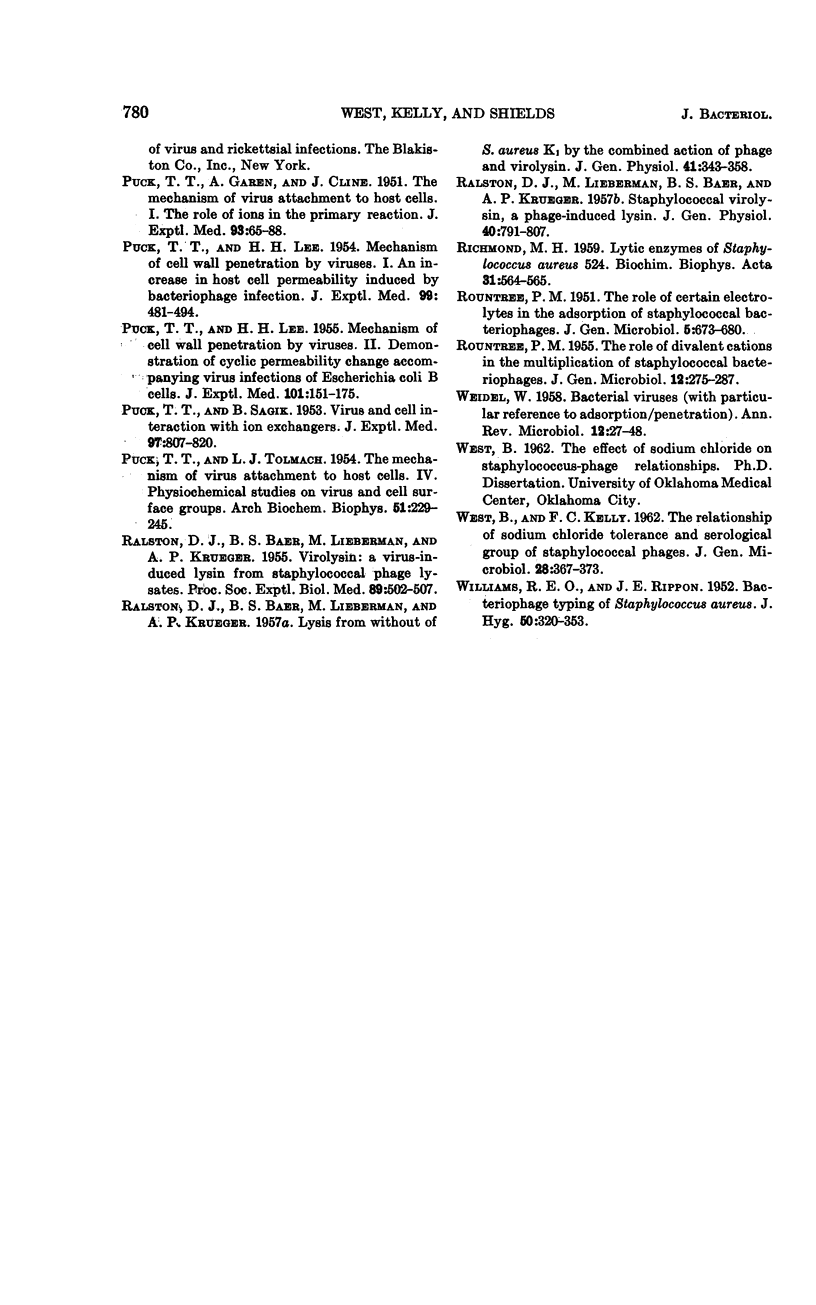Abstract
West, B. (University of Oklahoma Medical Center, Oklahoma City), Florene C. Kelly, and Doris A. Shields. Effect of sodium chloride on staphylococcus-phage relationships. J. Bacteriol. 86:773–780. 1963.—Phage patterns of 21 phage-propagating strains of staphylococci on medium with high NaCl content appeared to be an expression of the staphylococcal cells, as well as of the salt tolerance of the phages. Serological group A phages, previously found to be NaCl-tolerant in the free state, were capable of lysing susceptible staphylococci on 3, 7.5, and 10% NaCl Trypticase Soy Agar. None of the other phages tested was active when the medium contained 7.5 and 10% NaCl. Increasing the NaCl content of the medium rarely resulted in nonspecific reactions; rather the effect was, generally, a narrowing of the phage spectrum of the cells, with persistence in the phage pattern of the phage, or phages, which were propagated on the cells being tested. Although NaCl tolerance of the phages was the chief limiting factor of phage activity in the presence of 7.5 and 10% NaCl, reactions on salt medium also depended on the degree of susceptibility of cells to phage on routine typing medium and to certain other unexplained factors. In some instances, under the influence of increased NaCl, significant lysis at 1000 RTD was replaced by thinning of growth (inhibition), with or without the presence of plaques. Conversely, certain phage-cell combinations, which gave inhibition at 1000 RTD on standard medium produced some degree of lysis when the NaCl concentration was increased. Studies of phage 81 and its propagating strain showed that replication of phage occurred in 10% NaCl medium, although adsorption diminished as salt concentration was increased, and the time required to reach maximal lytic activity was delayed.
Full text
PDF







Selected References
These references are in PubMed. This may not be the complete list of references from this article.
- ADAMS M. H., PARK B. H. An enzyme produced by a phage-host cell system. II. The properties of the polysaccharide depolymerase. Virology. 1956 Dec;2(6):719–736. doi: 10.1016/0042-6822(56)90054-x. [DOI] [PubMed] [Google Scholar]
- BEUMER-JOCHMANS M. P. Etude de l'activité bactériostatique du bactériophage staphylococcique H. Ann Inst Pasteur (Paris) 1953 Oct;85(4):483–491. [PubMed] [Google Scholar]
- CHERRY W. B., WATSON D. W. The Streptococcus lactis host-virus system; characteristics of virus growth and the effect of electrolytes on virus adsorption. J Bacteriol. 1949 Nov;58(5):611–620. doi: 10.1128/jb.58.5.611-620.1949. [DOI] [PMC free article] [PubMed] [Google Scholar]
- Eklund C., Wyss O. ENZYME ASSOCIATED WITH BACTERIOPHAGE INFECTION. J Bacteriol. 1962 Dec;84(6):1209–1215. doi: 10.1128/jb.84.6.1209-1215.1962. [DOI] [PMC free article] [PubMed] [Google Scholar]
- MURPHY J. S. A phage-associated enzyme of Bacillus megaterium which destroys the bacterial cell wall. Virology. 1957 Dec;4(3):563–581. doi: 10.1016/0042-6822(57)90086-7. [DOI] [PubMed] [Google Scholar]
- PARK B. H. An enzyme produced by a phage-host cell system. I. The properties of a Klebsiella phage. Virology. 1956 Dec;2(6):711–718. doi: 10.1016/0042-6822(56)90053-8. [DOI] [PubMed] [Google Scholar]
- PUCK T. T., GAREN A., CLINE J. The mechanism of virus attachment to host cells. I. The role of ions in the primary reaction. J Exp Med. 1951 Jan;93(1):65–88. doi: 10.1084/jem.93.1.65. [DOI] [PMC free article] [PubMed] [Google Scholar]
- PUCK T. T., LEE H. H. Mechanism of cell wall penetration by viruses. I. An increase in host cell permeability induced by bacteriophage infection. J Exp Med. 1954 May 1;99(5):481–494. doi: 10.1084/jem.99.5.481. [DOI] [PMC free article] [PubMed] [Google Scholar]
- PUCK T. T., LEE H. H. Mechanism of cell wall penetration by viruses. II. Demonstration of cyclic permeability change accompanying virus infection of Escherichia coli B cells. J Exp Med. 1955 Feb 1;101(2):151–175. doi: 10.1084/jem.101.2.151. [DOI] [PMC free article] [PubMed] [Google Scholar]
- PUCK T. T., TOLMACH L. J. The mechanism of virus attachment to host cells. IV. Physicochemical studies on virus and cell surface groups. Arch Biochem Biophys. 1954 Jul;51(1):229–245. doi: 10.1016/0003-9861(54)90470-1. [DOI] [PubMed] [Google Scholar]
- PUCK T., SAGIK B. Virus and cell interaction with ion exchangers. J Exp Med. 1953 Jun;97(6):807–820. doi: 10.1084/jem.97.6.807. [DOI] [PMC free article] [PubMed] [Google Scholar]
- RALSTON D. J., BAER B. S., LIEBERMAN M., KRUEGER A. P. Lysis from without of S. aureus K1 by the combined action of phage and virolysin. J Gen Physiol. 1957 Nov 20;41(2):343–358. doi: 10.1085/jgp.41.2.343. [DOI] [PMC free article] [PubMed] [Google Scholar]
- RALSTON D. J., BAER B. S., LIEBERMAN M., KRUEGER A. P. Virolysin: a virus-induced lysin from staphylococcal phage lysates. Proc Soc Exp Biol Med. 1955 Aug;89(4):502–507. doi: 10.3181/00379727-89-21859. [DOI] [PubMed] [Google Scholar]
- RALSTON D. J., LIEBERMAN M., BAER B., KRUEGER A. P. Staphylococcal virolysin, a phage-induced lysin; its differentiation from the autolysis of normal cells. J Gen Physiol. 1957 May 20;40(5):791–807. doi: 10.1085/jgp.40.5.791. [DOI] [PMC free article] [PubMed] [Google Scholar]
- RICHMOND M. H. Lytic enzymes of Staphylococcus aureus 524. Biochim Biophys Acta. 1959 Feb;31(2):564–565. doi: 10.1016/0006-3002(59)90041-1. [DOI] [PubMed] [Google Scholar]
- ROUNTREE P. M. The role of certain electrolytes in the adsorption of staphylococcal bacteriophages. J Gen Microbiol. 1951 Oct;5(4):673–680. doi: 10.1099/00221287-5-4-673. [DOI] [PubMed] [Google Scholar]
- ROUNTREE P. M. The role of divalent cations in the multiplication of staphylococcal bacteriophages. J Gen Microbiol. 1955 Apr;12(2):275–287. doi: 10.1099/00221287-12-2-275. [DOI] [PubMed] [Google Scholar]
- WEIDEL W. Bacterial viruses; with particular reference to adsorption/penetration. Annu Rev Microbiol. 1958;12:27–48. doi: 10.1146/annurev.mi.12.100158.000331. [DOI] [PubMed] [Google Scholar]
- WEST B., KELLY F. C. Relationship of sodium chloride tolerance and serological group of staphylococcal phages. J Gen Microbiol. 1962 Jun;28:367–373. doi: 10.1099/00221287-28-2-367. [DOI] [PubMed] [Google Scholar]
- WILLIAMS R. E. O., RIPPON J. E. Bacteriophage typing of Staphylococcus aureus. J Hyg (Lond) 1952 Sep;50(3):320–353. doi: 10.1017/s002217240001963x. [DOI] [PMC free article] [PubMed] [Google Scholar]


